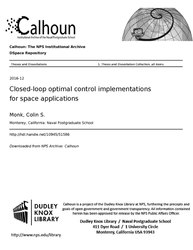File:Closed-loop optimal control implementations for space applications (IA closedloopoptima1094551586).pdf

Original file (1,275 × 1,650 pixels, file size: 5.32 MB, MIME type: application/pdf, 210 pages)
Captions
Captions
Summary[edit]
| Closed-loop optimal control implementations for space applications
( |
||
|---|---|---|
| Author |
Monk, Colin S. |
|
| Title |
Closed-loop optimal control implementations for space applications |
|
| Publisher |
Monterey, California: Naval Postgraduate School |
|
| Description |
This thesis explores concepts for a closed-loop optimal control implementation of minimum-time attitude maneuvers of spacecraft. The most common implementation of optimal control solutions is via open-loop commands. However, ignorance of the true system parameters can undermine the open-loop optimal control solution. While traditional closed-loop control methods can compensate for significant levels of uncertainty, this comes at the cost of optimality. This work focuses on optimization of eigenaxis maneuvers, but the concepts are not limited to this constraint. The study begins with an examination of candidate control architectures, weighing the advantages of various closed-loop feedback architectures. A control architecture consisting of a traditional proportional-derivative (or quaternion error) feedback loop and a feed-forward control torque signal is deemed to have the best performance and is then selected for further study. Next, through the analyses of a series of optimal control problems, several real-time optimal control algorithms are developed that continuously adapt to feedback on the system's actual states throughout the maneuver. These algorithms demonstrate significant performance improvements over conventional open-loop implementations, most notably shorter overall maneuver times. The results of this work, therefore, provide an algorithmic enhancement of spacecraft agility. Subjects: optimal control; closed-loop control; real-time optimal control; eigenaxis; state prediction |
|
| Language | English | |
| Publication date | December 2016 | |
| Current location |
IA Collections: navalpostgraduateschoollibrary; fedlink |
|
| Accession number |
closedloopoptima1094551586 |
|
| Source | ||
| Permission (Reusing this file) |
This publication is a work of the U.S. Government as defined in Title 17, United States Code, Section 101. Copyright protection is not available for this work in the United States. | |
Licensing[edit]
| Public domainPublic domainfalsefalse |
This work is in the public domain in the United States because it is a work prepared by an officer or employee of the United States Government as part of that person’s official duties under the terms of Title 17, Chapter 1, Section 105 of the US Code.
Note: This only applies to original works of the Federal Government and not to the work of any individual U.S. state, territory, commonwealth, county, municipality, or any other subdivision. This template also does not apply to postage stamp designs published by the United States Postal Service since 1978. (See § 313.6(C)(1) of Compendium of U.S. Copyright Office Practices). It also does not apply to certain US coins; see The US Mint Terms of Use.
|
 | |
| This file has been identified as being free of known restrictions under copyright law, including all related and neighboring rights. | ||
https://creativecommons.org/publicdomain/mark/1.0/PDMCreative Commons Public Domain Mark 1.0falsefalse
File history
Click on a date/time to view the file as it appeared at that time.
| Date/Time | Thumbnail | Dimensions | User | Comment | |
|---|---|---|---|---|---|
| current | 18:31, 15 July 2020 |  | 1,275 × 1,650, 210 pages (5.32 MB) | Fæ (talk | contribs) | FEDLINK - United States Federal Collection closedloopoptima1094551586 (User talk:Fæ/IA books#Fork8) (batch 1993-2020 #11480) |
You cannot overwrite this file.
File usage on Commons
The following page uses this file:
Metadata
This file contains additional information such as Exif metadata which may have been added by the digital camera, scanner, or software program used to create or digitize it. If the file has been modified from its original state, some details such as the timestamp may not fully reflect those of the original file. The timestamp is only as accurate as the clock in the camera, and it may be completely wrong.
| Short title | Closed-loop optimal control implementations for space applications |
|---|---|
| Image title | |
| Author | Monk, Colin S. |
| Software used | Monk, Colin S. |
| Conversion program | Adobe PDF Library 11.0 |
| Encrypted | no |
| Page size | 612 x 792 pts (letter) |
| Version of PDF format | 1.4 |

